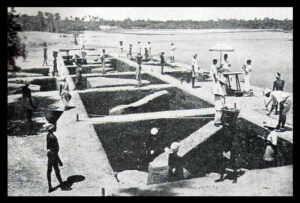
Nestled on the southeastern shores of India, within the Union Territory of Puducherry, lies the mysterious Arikamedu archaeological site. This unpretentious town, transformed into a charming village, conceals within its confines a treasure trove of historical riches that extend across numerous centuries. As we embark on a voyage through the corridors of history, we shall embark on an exploration of the enthralling past of Arikamedu, an ancient harbour town that once held a pivotal role in linking India with the far-off lands of the Mediterranean – an intriguing chapter woven into the tapestry of Indian history.
Arikamedu stands as a place where the sands of time meticulously preserve a vibrant tapestry of historical events. Its origins can be traced back to the 2nd century BCE when it went by the name “Podouke” in the eyes of the Romans. Arikamedu thrived as a bustling port town, serving as a crucial trade nexus between the Roman Empire and the southern reaches of India. This symbiotic connection facilitated the exchange of not only goods but also cultures and ideas, rendering Arikamedu a melting pot of diverse influences.
During its zenith, Arikamedu emerged as a maritime trade hub, welcoming Roman vessels laden with an array of treasures, including precious gemstones, exquisite glassware, fine wines, and artisanal pottery. In return, they departed with prized Indian commodities such as fragrant spices, intricate textiles, and semi-precious gemstones. The presence of Roman coins and the abundance of amphorae at the site serve as tangible testimony to the flourishing trade that transpired.
One of the most remarkable discoveries at Arikamedu was a trove of Roman amphorae, containers designed for transporting wine and olive oil. These vessels were found in abundance, bearing witness to the thriving commerce between these two ancient civilizations. It’s a captivating endeavour to envision the fragrant aromas of exotic spices and the resonant clink of coins in the bustling marketplaces of this prosperous town.
Arikamedu transcended its role as a mere marketplace; it thrived as a vibrant melting pot where cultures and ideas intermingled. It served as a conduit for the exchange of not only goods but also religious beliefs, architectural styles, and artistic influences. This rich tapestry of cross-cultural interaction becomes evident when examining the archaeological remnants.
The town’s architectural legacy beautifully exemplifies the harmonious fusion of Roman and Indian styles. Roman columns, etched with the symbolism of Roman deities, stand in unison with distinctly Indian stupa-like structures. This fusion of architectural elements vividly portrays the unique character of Arikamedu, a place where two worlds converged, each leaving an indelible mark on the other.
Among the most captivating facets of Arikamedu’s history lies its connection to bead making. The site has yielded a substantial trove of glass beads, with some being locally crafted and others imported. The art of crafting glass beads thrived among the denizens of Arikamedu, adding to the town’s distinctive identity.
These beads, often adorned with intricate designs, garnered significant demand within the Roman world. Contemplating the intricacies of this ancient industry is truly fascinating. Skilled artisans crafted these beads, destined to traverse oceans and grace the necks and wrists of Romans. Beyond their decorative allure, these beads served as tangible symbols of the profound connections binding Arikamedu and the Roman Empire.

Much like many grand cities of antiquity, Arikamedu’s splendour gradually faded with the passage of time. The decline of the Roman Empire, coupled with shifts in trade routes, ultimately led to the town’s abandonment. Arikamedu, once a bustling epicentre of commerce and cultural exchange, quietly slipped into obscurity.
The remarkable tale of Arikamedu might have remained concealed beneath layers of earth had it not been for the tireless efforts of archaeologists. The site has been the focal point of extensive archaeological excavations since the late 1940s, led by esteemed archaeologists such as Mortimer Wheeler and Vimala Begley.
Their meticulous excavations have unearthed a treasure trove of artifacts, bestowing invaluable insights into the town’s history. These artifacts, nestled within the layers of earth from which they emerged, have enabled archaeologists to intricately weave together the narrative of Arikamedu’s past.
The absence of written records from that era indeed poses a challenge in painting a comprehensive picture of Arikamedu’s past. Nevertheless, the archaeological evidence serves as a tangible bridge to a bygone time, where diverse cultures converged and trade flourished.
Today, Arikamedu stands as a testament to the enduring legacy of an ancient port town. This archaeological site, now meticulously preserved as a historical park, offers visitors the chance to journey back in time and immerse themselves in the vibrant history of the region. The remnants of Roman pottery, ancient beads, and architectural relics serve as silent witnesses to an era when Arikamedu bridged the gap between the East and the West.
Efforts to safeguard and promote this site have been undertaken by the Archaeological Survey of India and the Government of Puducherry. Their goal is to ensure that Arikamedu’s historical significance remains vivid and that forthcoming generations can explore the rich tapestry of its past.
The narrative of Arikamedu continues to captivate archaeologists, historians, and travellers alike. As we delve into its archaeological troves and contemplate its enigmas, we’re transported to a bygone era of vibrant marketplaces, cultural fusion, and the exchange of intellectual pursuits. Arikamedu’s legacy serves as an enduring testament to the profound connections between civilizations and the timeless allure of history.

